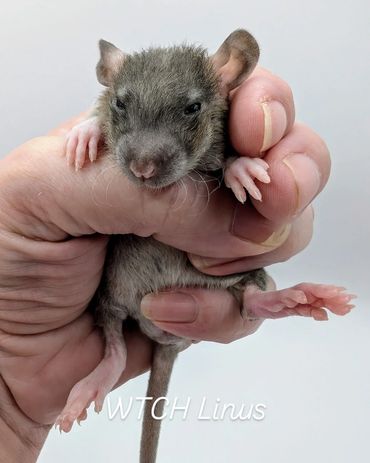
The Hairless Project
Producing Pet Rats with the Hairless Gene
On February 13, 2025, I paired two of my rats for a line breed. They are a father-daughter pair, and my goal was to promote the fabulous temperament of each and pass it along down the line. In the wild, rats live in colonies, and often interbreed, so incest isn't something that negatively affects them. Pairing closely related rats helps to amplify desirable traits, and allow breeders to weed out the bad, and less desirable traits with selective breeding. The pair I chose was WTCH Chopper Tom, and his daughter WTCH Rosalina. Little did I know, this pairing would produce quite a surprise for me.
On March 11, 2025, I was blessed with the birth of a truly special litter.
At first, the babies seemed normal, and I presumed they were the usual standard rats with standard coats and standard ears, like their parents.
I didn't expect what was discovered once the litter of eight babies got a little bigger and grew whiskers.
Once their whiskers grew in, then I had a clue! Their whiskers were tightly curled! It was so unexpected!
I consulted with my mentor and my partner, to confirm, because my mind was kind of boggled (ha ha, rats boggle, pun intended).
We reviewed the pedigree, and that's when my mentor pointed out; there is a hairless genetic controbutor further back in the generations (a great great grandparent), and pairing Tom and Rosie had the effect of causing it to be expressed in four of the baby rats!
So began my project for working with hairless rats.
In pet rats, the true hairless gene (not Double Rex, that is a different gene) is recessive. This means two copies of the gene are required for a rat with hairless expression (appearance) to be produced. Hairless rats have a specific gene that causes them to have little to no fur, where double Rex is two stacked copies of the dominant Rex gene, which results in a rat with fur that is so tightly curled that it breaks off and causes the rat to appear hairless with sparse or limited hair.
Hairless rats are just like standard rats in terms of their needs for nutrition and husbandry. They do not need special care, food, or environments, and can be housed with other standard rats safely.
Occasionally, hairless rats will experience a condition called entropion. This means the margin of their eyelid is curved inward, toward the eyeball, and can cause chronic pain and irritation, however, breeders will select against (opt not to breed) rats with this issue, to prevent passing it down along the line.
It is also recommended that hairless females are not used for breeding purposes, as they can experience problems lactating, as well as accidentally suffocating babies due to a lack of fur between the skin of the mother and her babies.
For this reason, it's advised to breed hairless males to standard (furred) females who carry the hairless gene.
My plan now, is to breed hairless males to their furred sisters to achieve the hairless x hairless carrier pairing, and continue producing babies who express the gene, as well as babies who do not. As this is my first experience in breeding hairless, the first few generations will not be available to pet homes or breeders. I need to hold back the rats produced for observation of their overall health and longevity, and to ensure they haven't got other issues that could be problematic for pet owners or other breeders.
This page is intended to showcase my progress on this project, and I will announce when or if my hairless rats become available.

Linus and I 💜
The Peanuts Gang - Generation 1












